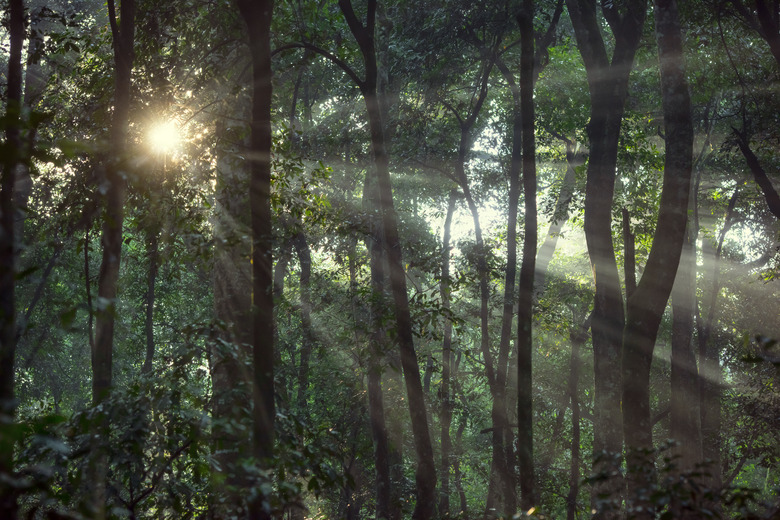Plants In The Canopy Layer Of The Rainforest
The tropical rainforest is home to a wide variety of plant and animal species, many of which exist nowhere else on earth. The thick tree canopy prevents many plants from reaching the sunlight they need to grow, creating a dark area with little vegetation around the tree roots.
Most life in the rainforest exists in the canopy layer. Canopy layer plants have adapted to live in the canopy itself, either by climbing existing rainforest trees to reach the light or living entirely in the treetops.
Layers of the Rainforest
Layers of the Rainforest
The rainforest is made up of four distinct layers:
1. Emergent Layer 2. Canopy Layer 3. Understory 4. Forest Floor
The emergent layer is the very top layer of the rainforest. This layer consists of the enormous trees and plants that live in rainforests that extend above all other plants in the area. They extend up and reach the direct sunlight. Their mushroom shaped tops block almost all sunlight from filtering to the layers below.
The canopy layer is where an estimated 90% of all tropical rainforest life exists. Canopy layer plants form a canopy of leaves and plant matter across the top of the layer. Because most of the light is blocked by the emergent layer, the canopy layer is dense with plants desperately trying to reach the light that filters down, which means branches are covered with flowers, vines, plants and other organisms.
Orchids
Orchids
Orchids make up one of the largest, most varied flowering plant families with over 20,000 known species. Orchids are very common in tropical regions, where most species are epiphytes. Epiphytes are plants that spend their whole lives living on another plant. These types of plants are abundant in the canopy layer of the rainforest since plants need to attempt to reach sunlight and water by climbing up tall and sturdy canopy layer plants.
These flowers grow non-parasitically on trees, absorbing water from rain and tree cavities and drawing energy from the sunlight that reaches through the canopy. They attract moths and flies to fertilize their flowers.
Hemiepiphytes
Hemiepiphytes
Hemiepiphytes begin their lives in the canopy, similar to epiphytes, but over the course of their lives, they slowly grow roots down to the ground. Dry conditions in the canopy mean this process takes a long time, but once roots reach the soil, these plants start growing more quickly. They may then harm their host tree.
For instance, the strangler fig, a vine-like member of the fig family, tends to slowly surround its host tree and eventually suffocates it. The host tree dies and decays, leaving a hollow-centered strangler growing in its place.
Lianas, Vines and Creepers
Lianas, Vines and Creepers
Lianas, vines and creepers all start their lives on the ground in a shrub-like shape or crawling along as a vine. Once they reach a nearby tree trunk, these plants change their growth structure and ascend into the canopy to seek out light. These plants keep their roots in the soil and never draw nutrients from the tree.
However, their ascent into the canopy can cause problems for the host tree. Their weight and climbing habits can eventually kill the tree that supports them. According to Monga Bay, these plants contribute to tree mortality in the rainforest, and keep this habitat diverse.
Bromeliads
Bromeliads
Like orchids, bromeliads are a type of ephiphyte. They spend their whole lives in the rainforest canopy, their roots never touching the ground. These pineapple relatives have waxy, thick leaves that create a bowl shape.
Bromeliads capture water for later use, and often provide homes for aquatic and semi-aquatic canopy creatures, including frogs, salamanders, snails, mosquito larvae and beetles. The large tank bromeliad can hold over two gallons of water, and is often used as a tadpole nursery by frogs.
Cite This Article
MLA
Palmer, G.D.. "Plants In The Canopy Layer Of The Rainforest" sciencing.com, https://www.sciencing.com/plants-canopy-layer-rainforest-8122581/. 22 November 2019.
APA
Palmer, G.D.. (2019, November 22). Plants In The Canopy Layer Of The Rainforest. sciencing.com. Retrieved from https://www.sciencing.com/plants-canopy-layer-rainforest-8122581/
Chicago
Palmer, G.D.. Plants In The Canopy Layer Of The Rainforest last modified March 24, 2022. https://www.sciencing.com/plants-canopy-layer-rainforest-8122581/
